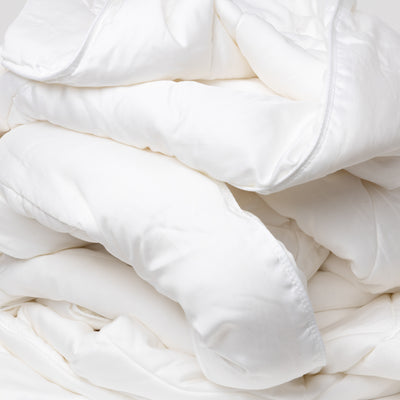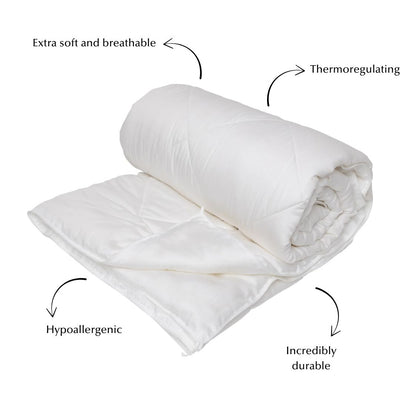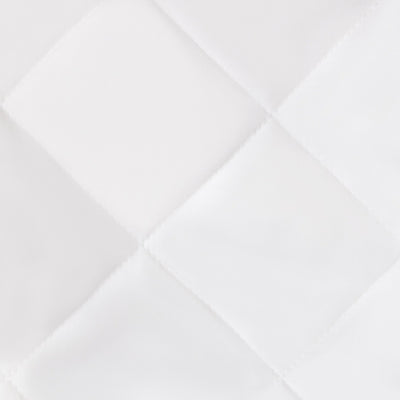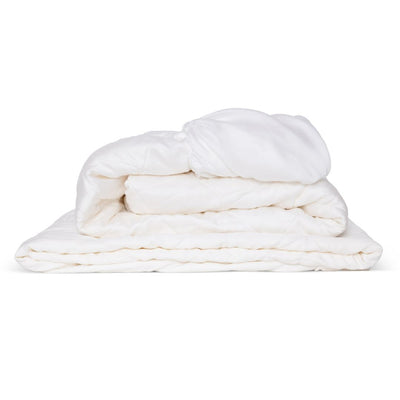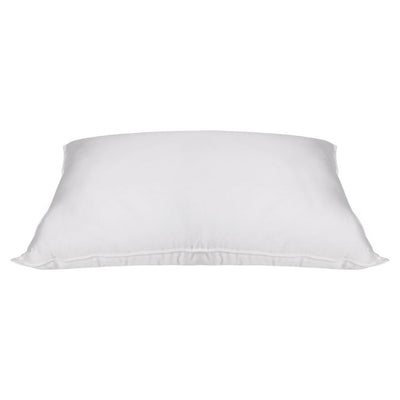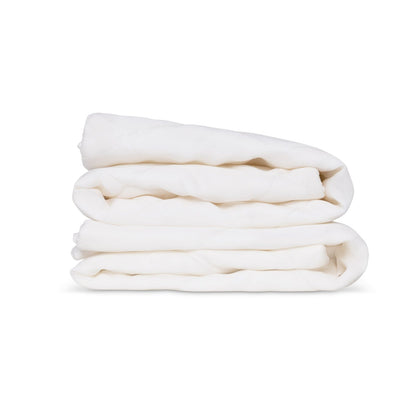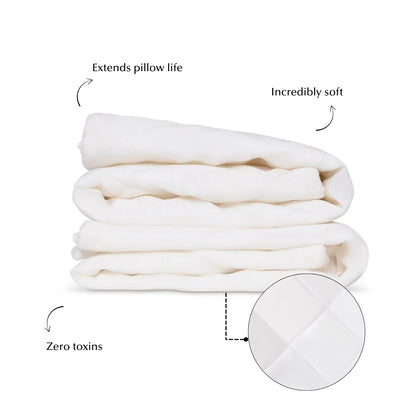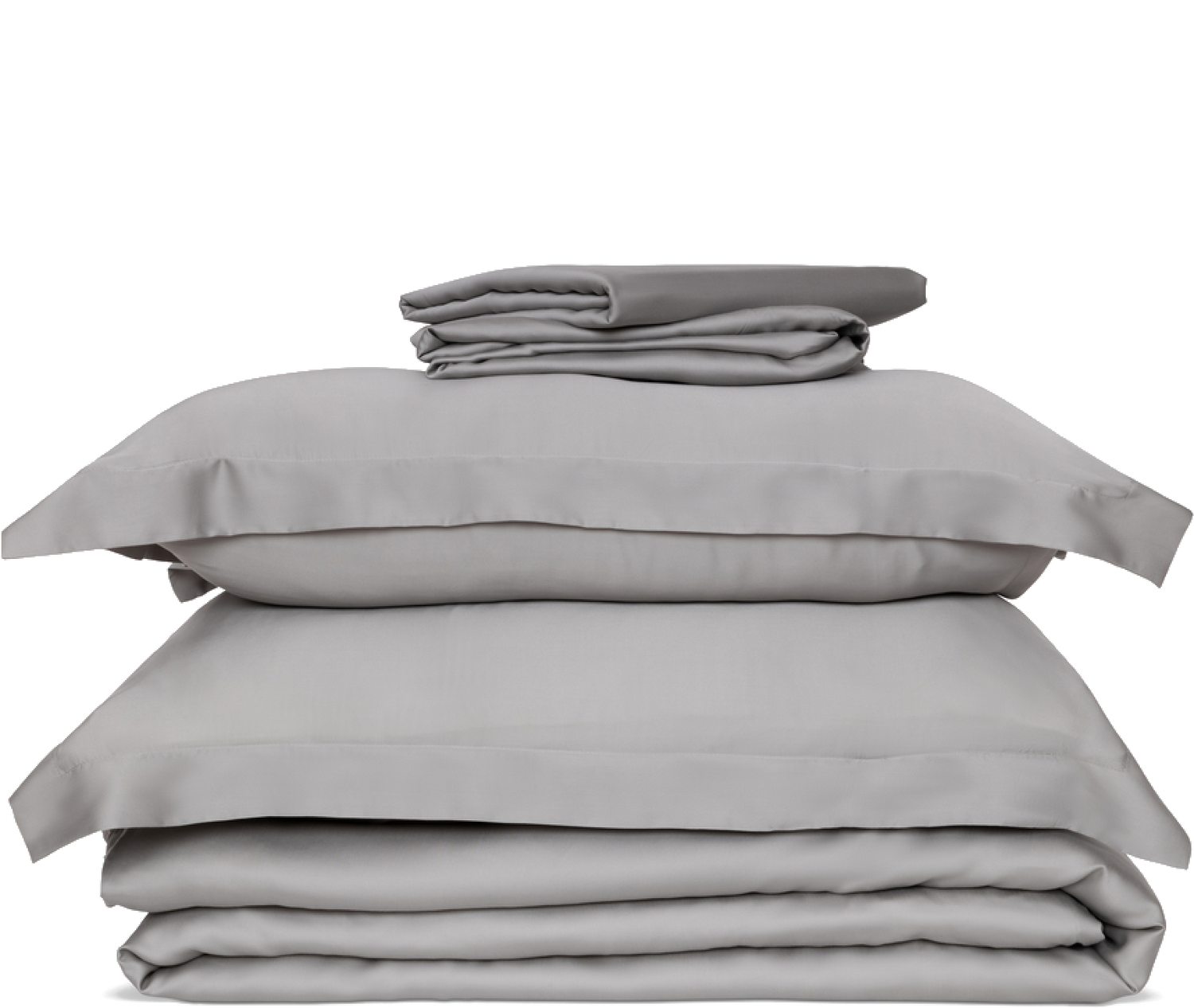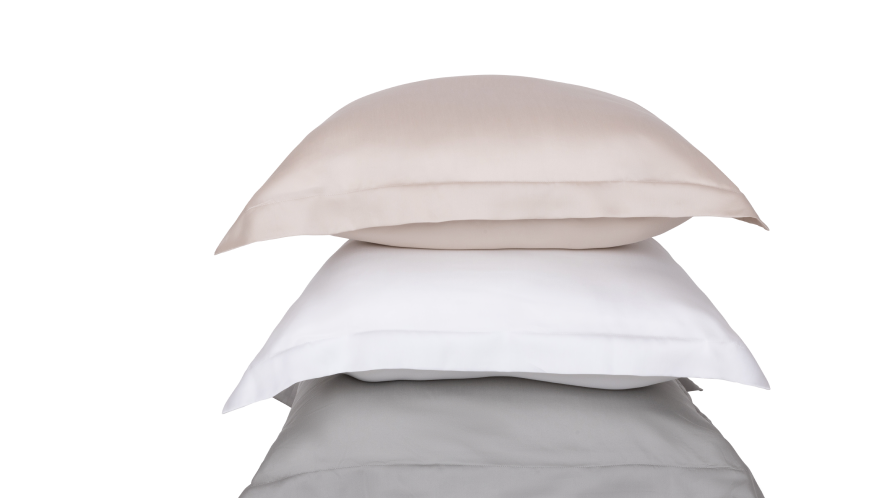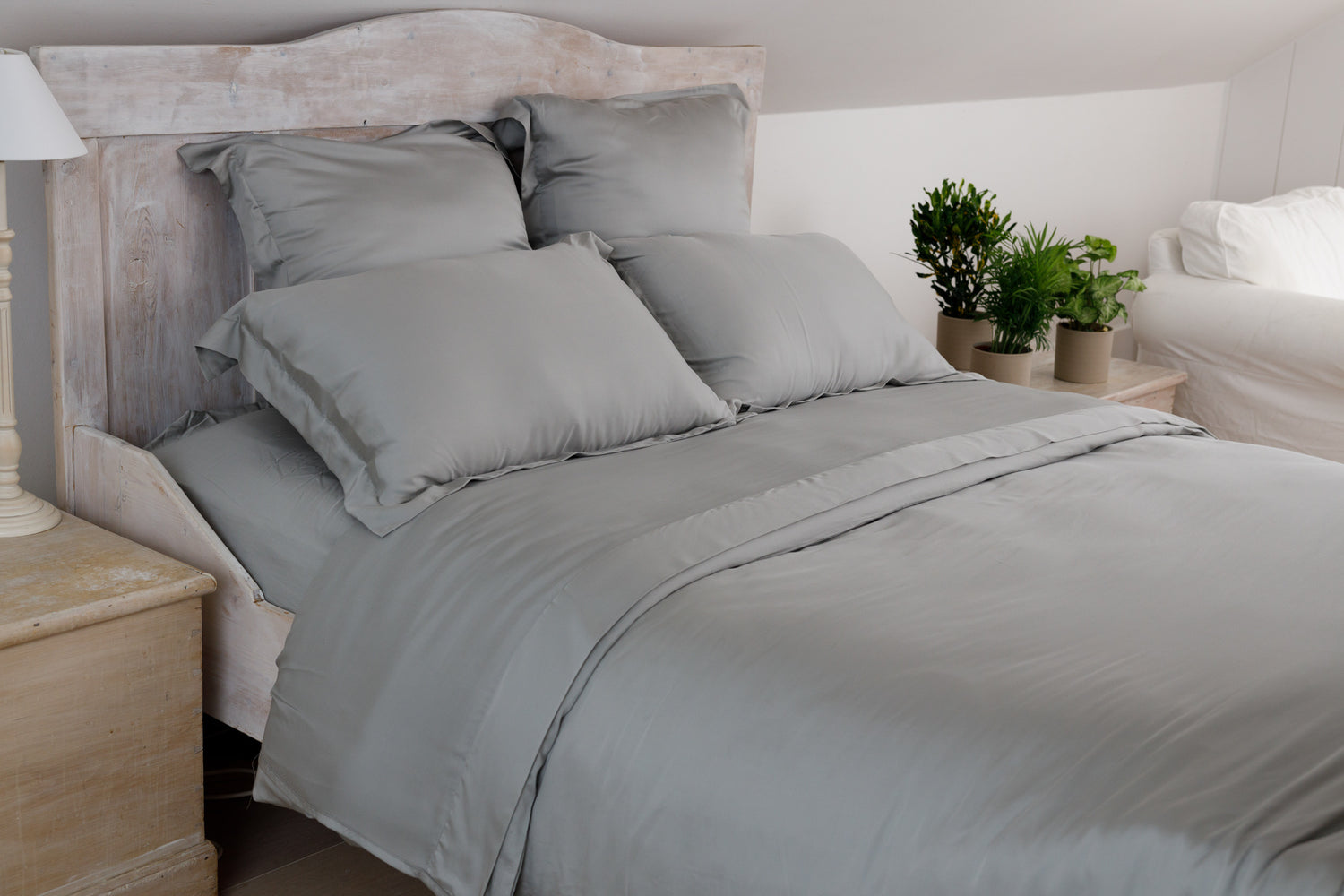Whether you’re regularly woken up by sneezing or sniffling, suffer from impromptu coughing and itching, or maybe you just want to keep asthma and eczema at bay, you’ve come to the right place for the lowdown on hypoallergenic bedding.
In this article, we’ve explained what anti-allergy sheets are, the best hypoallergenic fabrics and the features to look out for, and alternative ways to fight off common allergens.
What are hypoallergenic bed sheets?
Traditional bedding, while comfortable and cosy, has long-been known to house pesky allergens – from mites and mould to pet dander and dust.
For many people, these allergens can trigger respiratory or dermatological reactions, even if you didn’t previously realise you had an allergy – and if you already suffer from asthma or eczema, you might develop worsening symptoms.
However, there are a selection of materials that have been recognised as being naturally hypoallergenic, and anti-allergen bedding has been developed to combat these common allergens and give you a smoother, more enjoyable night’s sleep.
With this in mind, if you’re a regular nighttime sneezer or sniffler, keep on reading to discover the best hypoallergenic bed sheets, and other ways to fight off bedroom allergies.
Best hypoallergenic sheet types
From bamboo to silk and cotton, read all about the best hypoallergenic sheets and fabric types, to help inform your buying decision.
Bamboo sheets
An increasingly popular bedding fabric, bamboo sheets are made from the fast-growing, sustainable, and renewable bamboo plant. An eco-conscious sleeping solution, bamboo can grow in just about any environment, and the shoots are self-regenerative – meaning they regrow once harvested.
When it comes to anti-allergenic properties, bamboo is a leading textile. Not only is it soft and smooth, helping to take care of your skin and hair, but it’s also allergen-repellent, temperature regulating, and moisture wicking; so, you can enjoy a cool evening free of sweats, itching, or sneezing, no matter the temperature.
If this sounds up your street, discover more in our guide that goes into detail around the benefits of bamboo bedding and bed sheets.
Silk sheets
You’ll likely be familiar with silk’s soft and luxurious properties, each of which have made the fabric a popular long-time favourite among countless households; but you might not have realised that it’s actually great at fighting common allergens too.
In fact, the fibres are actually naturally designed to protect cocooning silk worms from the very same allergens (i.e. dust mites and mould), making them an effective barrier for people. Additionally, the silky softness will help to sooth sensitive skin, which comes in handy if you suffer from the likes of eczema.
However, there are a couple of downsides to traditional silk: not only is it one of the more expensive textiles, but it’s widely considered to be an unethical option. Fortunately, you can get the very same high-quality, long-lasting, and anti-allergenic properties of silk from its plant-based cousin – eucalyptus silk.
Tencel sheets
Another name for eucalyptus silk, Tencel is manufactured from the sustainable and renewable eucalyptus plant, and is naturally hypoallergenic, temperature regulating, and moisture wicking.
Not only does this mean you’ll enjoy a sneeze- and itch-free night, but you’ll remain cool and comfortable whether it’s the depths of winter or height of summer. If you’re interested in learning more about eucalyptus silk, explore our complete guide to Tencel.
Cotton sheets
One of the best-known fabrics, and a long-time popular pick, cotton sheets are a strong contender when comparing hypoallergenic bedding – especially if you’re looking at high-quality, long-staple Egyptian cotton (find out more about the difference between cotton and Egyptian cotton).
One thing to recognise about cotton, though, is that it can be relatively problematic, when compared to ethical alternatives like bamboo, eucalyptus silk, and Tencel. For instance, when it comes to cotton vs eucalyptus silk, manufacturing the latter requires 30% less energy and 95% less water, which is a whole lot better for your environmental footprint.
How to fight off bedroom allergens
Of course, while one of the biggest steps you can take to fight off bedroom allergens is buying new hypoallergenic bedding, there are a series of smaller methods you can adopt in the meantime.
- Try using a dehumidifier
Dehumidifiers and air purifiers are both great solutions if you’re struggling with allergens at home, and can almost-instantly help to alleviate symptoms and improve your quality of sleep and overall health.
If a dehumidifier isn’t an option, whether for budgetary or spatial reasons, instead try opening a window during the day to reduce the rate of accumulated condensation.
Essentially, if your bedroom air is too humid, you run the risk of damp and mould growth, which can become increasingly dangerous over time as your space becomes a hotbed of breeding dust mites – especially if you have some degree of asthma to begin with. Typically, you’ll want your room to have humidity levels sitting somewhere between 30-50% for a comfortable, allergen-light environment.
2. Regularly launder your sheets
You might not realise, but dust mites and mould absolutely thrive in warm, humid environments, and multiply like nobody’s business – and their droppings can be terrible for your allergies!
Unfortunately, the chances are your bedding fits this environmental description, especially if you suffer from night sweats or overheating, so it’s important to ensure your sheets are as inhospitable as possible – this means regularly washing to kill bacteria and germs.
It’s recommended to wash at the highest setting your bedding permits, though be careful with delicate textiles like silk, bamboo, or eucalyptus silk that might require a colder cycle.
It might sound obvious, but a simple way to keep your sheets clean and free of dirt and mould is to wait until after you’ve had a bath or shower before getting into bed.
This washes away the hidden allergens you may have picked up during the day, and keeps your bedding cleaner for longer (although, even if you get in the habit of washing before bed, we’d still suggest regularly laundering your sheets!).
4. Keep pets off your bed
They may be cute and cuddly, but your pets can quickly turn your bedroom into an allergenic nightmare if you’re not careful! For instance, when you invite your dog into bed for morning snuggles, you’re running the risk of hair, dander, and dead skin cells nestling into your sheets, creating the perfect feeding and breeding environment for dust mites.
As well as the hair itself, pet fur can also trap outdoor allergens like pollen and mould, which can worsen your eczema or asthma, so it’s safer to keep them away from the bedroom entirely.
Incidentally, other ways to keep your bedding free of dander and dust is to avoid eating in bed – you’d be surprised how many crumbs find their way between the sheets. And if you do spill something, make sure to wash your sheets (as above) as soon as possible to avoid bacterial or mite growth.
5. Invest in new bedding
As we’ve discussed earlier, though it’s well-worth touching on again, a long-term solution to allergenic illness or nighttime discomfort is to invest in high-quality, hypoallergenic bedding that not only prevents the growth of mites and mould, but actively combats their presence.
Typically, anti-allergy sheets, duvet covers, and pillowcases also come with the side-benefits of being naturally breathable and temperature regulating, which can be a great reliever if you suffer from common skin and breathing conditions.
Features to look for in the best hypoallergenic sheets
We’ve talked about the different types of hypoallergenic bedding, but what exactly should you be looking for in different materials – and how can you be sure that sheets will indeed be allergy-free as the label suggests?
To help you out, we’ve picked out five essential features to look out for when buying hypoallergenic sheets.
Thread count
Bed sheets with a higher thread count will typically be softer, which often means you can enjoy a more comfortable night’s sleep. The likes of bamboo, eucalyptus silk, and Egyptian cotton have high thread counts, and are less likely to cause skin irritation than coarser alternatives. Our complete guide to thread counts goes into more detail.
Material or fabric
As highlighted earlier, choosing a naturally hypoallergenic fabric will help to combat dust mites, mould, and bacterial growth, all of which can heighten or exacerbate respiratory or dermatological conditions.
Organic vs. non-organic
Because organic bedding is made without chemicals, it’s typically free of irritants (which can cause discomfort and worsen existing allergies). Additionally, naturally-occurring materials like bamboo are temperature-regulating, as opposed to synthetic fibres like polyester.
Breathability
Breathability is of great importance if you’re looking for hypoallergenic sheets and bedding, with breathable fibres absorbing sweat and letting heat escape your body – keeping you cool and comfortable all night long. For more, find out more about choosing cool bedding.
Certification
Perhaps the most obvious feature to look out for on hypoallergenic bedding is accreditation or certification. If the sheets have been endorsed by a recognised body, you can rely on the fabric to keep you comfortable, and you’ll have a much stronger chance of an allergy-free night.
So, there you have it – the complete guide to hypoallergenic sheets, and how to choose the best fabrics! If you’re feeling inspired, why not explore our complete range of hypoallergenic bedding, or discover more from our sleep experts over on the Ethical Bedding blog?

